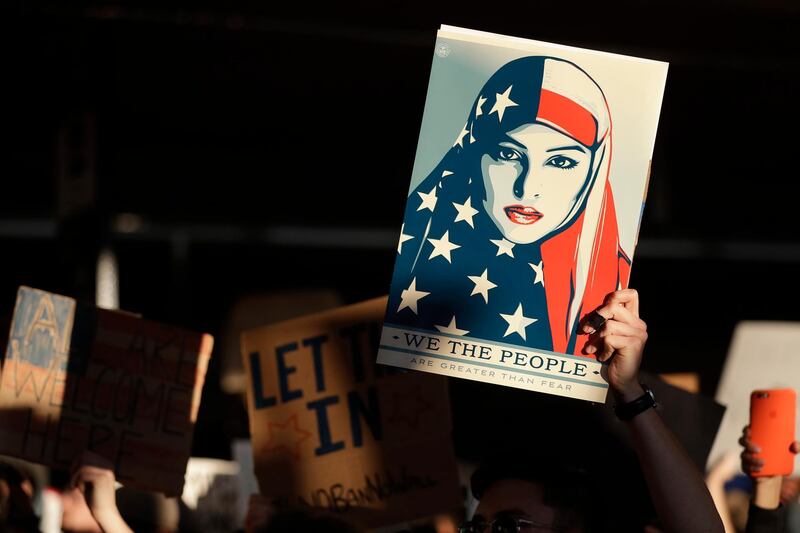In January, the graphic artist Shepard Fairey tapped directly into the American zeitgeist for a second time with a series of stencilled red, white and blue posters.
In the same way that Fairey's portrait of Barack Obama, emblazoned with the word "Hope", had become the iconic image of the 2008 United States presidential election campaign, the artist's images of young American women bearing the slogan "We the People" captured the spirit of popular protest that accompanied Donald Trump's inauguration.
One featured a dreadlocked child while another showed a proud and defiant Latina, but it was the third, of a woman wearing the flag of the US as a hijab, that sent Fairey's graphic protest campaign viral.
An image of pride, dignity and openness, the poster was based on a photograph of a young Bangladeshi-American woman, Munira Ahmed, that had been taken a decade earlier near the New York Stock Exchange by the Syrian-American photographer Ridwan Adhami who, like Ahmed, had grown up in the New York borough of Queens.
Fairey's high-contrast image and Adhami's photo asked similar questions: what is the status of women and Muslims in Trump's America; are American and Muslim identities compatible; and how can they be reconciled when the US military has been deployed throughout the Islamic world for more than two decades?
Some of these questions, and many more are the subject of a forthcoming panel discussion at the Anderson Ranch Arts Centre in Aspen, Colorado, as part of its 2017 Summer Series.
Moderated by the bestselling author and sociologist Sarah Thornton, Sisters on Top: Art-world professionals talk about Islam, Immigration and Ingenuity features the Syrian-American artist Diana Al Hadid, the Karachi-born sculptor Huma Bhabha and the pioneering gallerist Leila Heller, who has been championing art from the Middle East since the early 1980s.
"I really think there's a magic in bringing intelligent people together and the meal that gets made from their participation is unpredictable and that's wonderful," Thornton tells me, looking forward to the event to be held tomorrow.
"This panel is about them but I'm interested in understanding the degree to which Islam is an issue in their work and the choices they make in subject matter and style, and the impact that it and their gender has had on their choices and careers." Thornton has plenty of experience in getting to grips with the factors that make cultural luminaries tick. A writer, ethnographer, journalist and sociologist, the Canadian and British citizen is the former chief correspondent on contemporary art for The Economist and has also written for Artforum, The New Yorker and more recently for Cultured Magazine, prompting The Washington Post to describe her as "the Jane Goodall of the art world".
Following a degree in art history, a PhD in sociology and time spent running an MA in media studies at Sussex University in the UK, during which she published her first book Club Cultures: Music, Media and Subcultural Capital, Thornton then started researching her second, which was published as Seven Days in the Art World in 2008.
Thornton's account of seven disparate days spent in various sectors of the world of contemporary art – including an auction and a biennale, a prize-giving and an art fair, an artist's studio and a student seminar at the California Institute of the Arts – was followed by 33 Artists in 3 Acts (2014) in which she asked figures such as Yayoi Kusama, Jeff Koons and Cindy Sherman two deceptively simple questions: "What is an artist?" and "What kind of artist are you?"
"I'm known for being particularly interested in these kind of issues and for asking the kind of questions that some art historians and critics maybe wouldn't want to ask, such as how the current political climate in America has affected someone's studio practice," Thornton says.
"Whereas for someone like me it's a genuine and open question. To some degree, contemporary art is a belief system and when you combine that with a belief system that's as powerful as Islam– with its panoply of beliefs and observances – that's an incredibly rich territory for discussion."
Given Thornton's fellow panelists, one wonders what answers she might get. Despite both being of Islamic heritage, Diana Al Hadid and Huma Bhabha are artists whose work is known for its engagement with issues that are only indirectly defined by gender or religion.
Born in Syria in 1981, Al Hadid's family made a life and career-defining journey from the Middle East to the Midwest when she was 5 years old, leaving Aleppo for Canton, a former manufacturing town in Ohio, a dislocation critics have focused on to explain Al Hadid's very visible interest in origin stories, history, memory and alienation.
"I don't mind when people circle around my biography or consider it, but I would encourage them to look at the form of my work and to really unpack it first," Al Hadid told me at the time of her 2016 solo show, Diana Al Hadid: Phantom Limb, at the New York University Abu Dhabi Art Gallery.
"I am a Syrian artist, but that's not the full story. I grew up in Ohio and that is a huge reason why I'm able to make the work that I make."
Read more: Acclaimed sculptor Diana Al Hadid on her NYUAD Art Gallery show
Born in Karachi, Pakistan, in 1962, but resident in the US since the mid-1980s, Bhabha is even more keen to resist being pigeonholed and admits she was surprised to be invited to take part in Sisters on Top.
"The topics of the talk are not ones that I consciously pay attention to in my work so I am curious myself to see how my participation will fit into the picture," she tells me from her home and studio in Poughkeepsie in upstate New York, where she engages in a studio practice she describes as being distinctly "old school".
"I've never considered being a female artist or being of Muslim descent reasons for making work and I've never felt that I've had to talk about those things because that is what I am," she insists.
"But the whole stance towards Islam and its demonisation is something that's been happening for at least 15 or 16 years – even before the invasions of Afghanistan and Iraq – and that's something I am very aware of and has been happening at a very steady pace because it's part of American foreign policy," the sculptor says.
Inspired by Robert Rauschenberg and Picasso, Bhabha's sculptures tend to be made from detritus and found objects and are the products of what her "hands can deliver", but despite this she admits to being interested in the bigger picture, even if this isn't immediately evident in her work.
"I am much more interested in why these wars are continuing and why they can't be stopped. How many people have to die? How much destruction has to go on for reasons that are not ever really explained?" she asks. "They keep finding reasons to continue these wars which are everywhere, but why is there never any diplomatic resolution to anything and why do people here, in a certain way, keep supporting them? Is it because they are ignorant or do they really not care about the huge number of people who have been affected and whose lives have been destroyed?"
Rather than politics however, it is the daily issues such as rising real estate prices and the effect of trying to succeed as an artist in New York's hyper-competitive art scene that have a greater impact on Bhabha's day-to-day, constant pressures that are also recognised by fellow panelist, the veteran gallerist Leila Heller.
"If you look at the scene in New York it's still very male-dominated," says the expatriate Iranian dealer who has been operating in Manhattan since 1982.
"In terms of auction prices, the prices achieved by female artists are still inferior – the top 20 artists by sales are all male – and if you look at who's controlling the art world from a gallery perspective it's the same, you have Gagosian, Hauser & Wirth, Zwirner, Acquavella. They're all men."
Despite feeling that there is "tremendous animosity" towards Islam and the Middle East at the moment, Heller says she's seen a sea-change in the way artists and works from the region are now considered, especially since she first started exhibiting the work of the now-renowned female Iranian artist Monir Farmanfarmaian in 1984.
"It started in London and Paris and then attitudes started to change in the United States," Heller recalls, insisting the change can be explained by increasing knowledge and education.
"When I did my first Monir Farmanfarmaian show I didn't sell a single work because nobody wanted to buy Iranian work after the US Embassy crisis, but after she had a solo show at the Guggenheim things really took off."
When it comes to the changing perception of artists and works from the Middle East, Heller believes much of the heavy lifting has been done by a generation of museum curators, many of whom are women, such as Sheila Canby at the Metropolitan Museum of Art, Linda Komaroff at the Los Angeles County Museum of Art and Venetia Porter at the British Museum, but Heller also credits the efforts that have been made from within the Middle East.
"I think that it's a total fallacy when people say that women in the Middle East aren't empowered, that they don't have any rights. There are female artists, gallery owners, directors and curators," says Heller, who first came to the UAE in 2003. "It's effectively a female-led art movement in the Gulf and that's something I find really empowering."
Summer Series: Sisters on Top: Art-world professionals talk about Islam, Immigration and Ingenuity. www.andersonranch.org/event/sisters-top-artists-talk-islam-immigration-ingenuity/
Read more:





